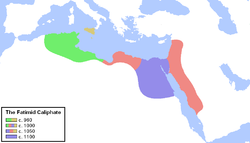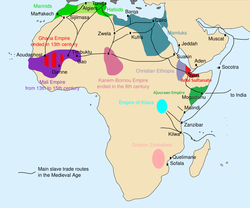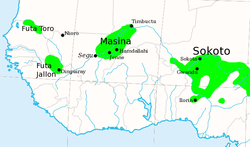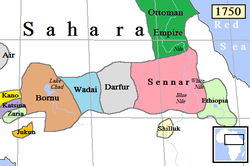North Africa
A list of known kingdoms and empires in North Africa that we have record of:
4th millennium BCE – 6th century CE
- Protodynastic period in Egypt: (preceded by various cultures in which it is unclear if the institution of kingship existed) (preceded by nomes and nomarchs)
- Lower Egypt Kingdom (3500–3100 BCE)
- Upper Egypt Kingdom (3400–3150 BCE)
- Early Dynastic Egypt [24] (3150–2686 BCE)
- Old Kingdom of Egypt [25] (2686–2181 BCE)

Old and Middle Kingdoms of Ancient Egypt - Kingdom of Kerma (2500–1500 BCE)
- First Intermediate Period in Egypt: (2181–2055 BCE)
- Middle Kingdom of Egypt [26] (2055–1650 BCE)
- Second Intermediate Period in Egypt (1700–1550 BCE)
- 14th dynasty at Xois (1700–1650 BCE)
- 15th dynasty and the Hyksos (1650–1550 BCE)
- Abydos dynasty (1640–1620 BCE)
- 16th dynasty (1650–1580 BCE)
- 17th dynasty (1571–1540 BCE)
- New Kingdom of Egypt (1550–1077 BCE)
- Third Intermediate Period in Egypt: (1077–664 BCE)
- 21st dynasty (1077–943 BCE)
- 22nd dynasty (943–716 BCE)
- 23rd dynasty (837–728 BCE)
- 24th dynasty (732–720 BCE)
- Kingdom of Kush (1070 BCE – 350 CE) and the 25th dynasty of Egypt/Kushite Empire (754–656 BCE)
- Ancient Carthage (814–146 BCE)
- Late Dynastic Egypt (664–525 BCE, 404–343 BCE)
- Battiadae Kingdom (631–440 BCE) (List of kings of Cyrene)
- Garamantes Kingdom (pre 5th century BCE – 7th century CE)
- Kingdom of Blemmyes (600 BCE – 3rd century CE)
- Ptolemaic Kingdom (305–30 BCE)
- Kingdom of Numidia (202–46 BCE) (preceded by Massylii Confederation)
- Kingdom of Mauretania (202 BCE – 25 BCE/44 CE)
- Kingdom of Nobatia (350–650 CE) (absorbed into Makuria)
- Kingdom of Ouarsenis (430–735 CE) (Roman–Berber kingdoms)
- Kingdom of the Vandals and Alans (435–534 CE)
- Kingdom of the Moors and Romans (477–599 CE)
- Kingdom of the Aurès (484–703 CE) (Kahina) (Roman–Berber kingdoms)
- Kingdom of Makuria (5th century–1518 CE) (Dongola as an interchangeable name prior to 1365? " [27] " and Qalidurut, in which there are contrasting titles for the same king) (its rump state after the 1365 civil war is often conflated as Dotawo and it is unknown whether the other polity in the civil war continued to hold Dongola prior to Funj conquest)
- Kingdom of Hodna [28] : 508 (5th century–7th century CE) (Hodna) (Roman–Berber kingdoms)
- Kingdom of Capsus (5th century–6th/7th century CE) (Gafsa) (Roman–Berber kingdoms)
- Nemencha Kingdom (5th century–7th century CE) (Roman–Berber kingdoms)
- Lagautan/Tripolis/Cabaon Kingdom (5th century–7th century CE) (Cabaon) (Roman–Berber kingdoms)
- Kingdom of the Dorsale [29] (510–7th century CE) (Roman–Berber kingdoms) (mentioned in Vandal Kingdom#Later years)
- Kingdom of Altava (578–708 CE) (Kusaila of Awraba) (Roman–Berber kingdoms)
- Principality of Tingitana [28] : 508 (6th century–7th century CE) (Mauretania Tingitana)
- Kingdom of Alodia/Alwa (6th century–1504 CE)
7th century – 12th century CE
- Dar Sila 'Wandering Sultanate' [30] (619–? CE)
- Emirate of Nekor (710–1019 CE)
- Barghawata/Tamasna Kingdom [31] (744–1058 CE) (Salih ibn Tarif)
- al–Rahman's Ifriqiya (745–755 CE)
- Ifranid Emirate of Tlemcen (757–790 CE) (Algeria)
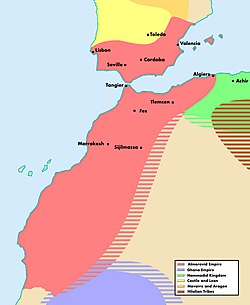
Almoravid Empire - Emirate of Sijilmassa (759–976 CE)
- Rustamid Imamate of Tahert (767–909 CE) (Algeria) (Tahert)
- Idrisid dynasty (789–974 CE) (Morocco)
- Imamate of Nafusa (8th century–911 CE)
- Aghlabid dynasty (800–909 CE) (Tunisia)
- Sulaymanid dynasty (814–922 CE) (Algeria)
- Tulunid dynasty (868–905 CE) (Egypt)
- Fatimid Caliphate (910–1171 CE) (born from Danhāǧa Confederation)
- Banu Khattab dynasty (918–1172/1177 CE) (Zawila) (Libya)
- Ikhshidid dynasty (935–969 CE) (Egypt) (Abu al–Misk Kafur)
- Banu Kanz dynasty (948–1365 CE) (Egypt/Sudan)
- Maghrawa dynasty (988–1069 CE) (Morocco)
- Banu Khazrun dynasty (1001–1146 CE) (Libya)
- M'zab (1012–16th century/1882 CE)
- Hammadid dynasty (1014–1152 CE) (Algeria) (born from Danhāǧa Confederation)
- Almoravid dynasty (1040–1147 CE) (Morocco and Western Sahara) (born from Aznag Confederation)
- Zirid dynasty (1048–1148 CE) (Algeria) (born from Danhāǧa Confederation)
- Khurasanid dynasty (1059–1128 CE, 1148–1158 CE) (Tunisia)
- Banu Ghaniya dynasty [32] (1180–1212 CE) (Tunisia)
- Almohad dynasty (1121–1269 CE) (Morocco) (born from Masmuda Confederation) (Tinmel)
- Ayyubid dynasty (1171–1254 CE) (Egypt)
Fatimid Caliphate - Guanches Guanartematos: (pre–15th century CE) (Gran Canaria)
- Daju kingdom (12th century–15th century CE) preceded by Tora (overthrown by Tunjur)
13th century – 18th century CE
- Emirate of Banu Talis (1228–1551 CE)
- Hafsid dynasty (1229–1574 CE) (Tunisia) (born from Masmuda Confederation)
- Zayyanid Kingdom of Tlemcen (1235–1556 CE) (Algeria) (born from Zenata Confederation)
- Marinid dynasty (1248–1465 CE) (Morocco) (born from Zenata Confederation)
- Mamluk Sultanate (1250–1517 CE)
- Bahri dynasty (1250–1382 CE)
- Burji dynasty (1382–1517 CE)
- Banu Makki dynasty (1282–1394 CE) (Tunisia)
- Hafsid Emirate of Béjaïa/Bougie (1285–1510 CE)
- Kingdom of al–Abwab (13th century–15th/16th century CE)
- Hafsid Emirate of Qusantina/Constantine [33] (CE 13th/14th century–1528) (Constantine)
- Banu Thabit dynasty (1324–1401 CE) (Libya)
- Zab Emirate (mid 14th century–1402 CE)
- Sultanate of Tuggurt (1414–1854/1871 CE) (vassal of Algiers (CE 1552–1812/1827)) (List of rulers of Tuggurt)
- Wattasid dynasty (1470–1554 CE) (Morocco) (born from Zenata Confederation)
- Tunjur kingdom (15th century–mid 17th century CE) (overthrown by Darfur)
- Abdallabi Kingdom (15th century–1504/1821 CE)

Senussi Order including sphere of influence circa 1880 - Kingdom of Fazughli (1500–1685 CE)
- Sultanate of Sennar/Funj (1504–1821 CE)
- Saadi Principality of Sus and Tagmadert (1509–1554 CE) (Sous) (at times ruled separately from Saadi Sultanate)
- Kingdom of Beni Abbas (1510–1872 CE)
- Kingdom of Kuku (1515–1638 CE)
- Regency of Algiers (1516/1659–1830 CE) (Odjak of Algiers Revolution)
- Fezzan Sultanate (1556–1804/1912 CE)
- Saadi dynasty (1554–1659 CE) (Morocco)
- Regency of Tunis (1574/1591/1613–1705 CE) (Muradid dynasty) succeeded by Beylik of Tunis (1705–1881 CE) (Husainid dynasty)
- Naqsid Principality of Tetouan (1597–1673 CE)
- Sultanate of Darfur (1603–1874 CE, 1898–1916 CE) (Keira dynasty)
- Republic of Bou Regreg (1627–1668 CE) (Elective monarchy?)
- Dila'iya Sultanate (1637–1668 CE)
- Alaouite dynasty (1666 CE–current) (SM of Morocco) (Makhzen)
- Dar Tama Sultanate [34] [30] : 450 (17th century CE–?) (Tama people)
- Tazerwalt (17th century CE)
- Regency of Tripoli (1551/1711–1835/1912 CE) (Karamanli dynasty)
- Taqali Kingdom (1750–1884 CE, 1889–1969 CE) (Tagale people)
19th century CE – present
- Emirate of Abdelkader/Mascara (1832–1847 CE)
- Dar Qimr Sultanate [34] [30] : 450 (1850–?/1945 CE) (mentioned in Sultan#West Asia and North Africa)
- Mahdist State (1885–1889 CE)
- Dar Masalit Sultanate [34] (19th century–early 20th century CE)
- Muhammad Ali dynasty (1914–1951 CE) (Egypt)
- Emirate of Cyrenaica (1949–1951 CE)
- Senussi dynasty (1951–1969 CE) (Libya) preceded by Senusiyya (1837 CE–present)
- Kingdom of Tunisia (1956–1957 CE)


